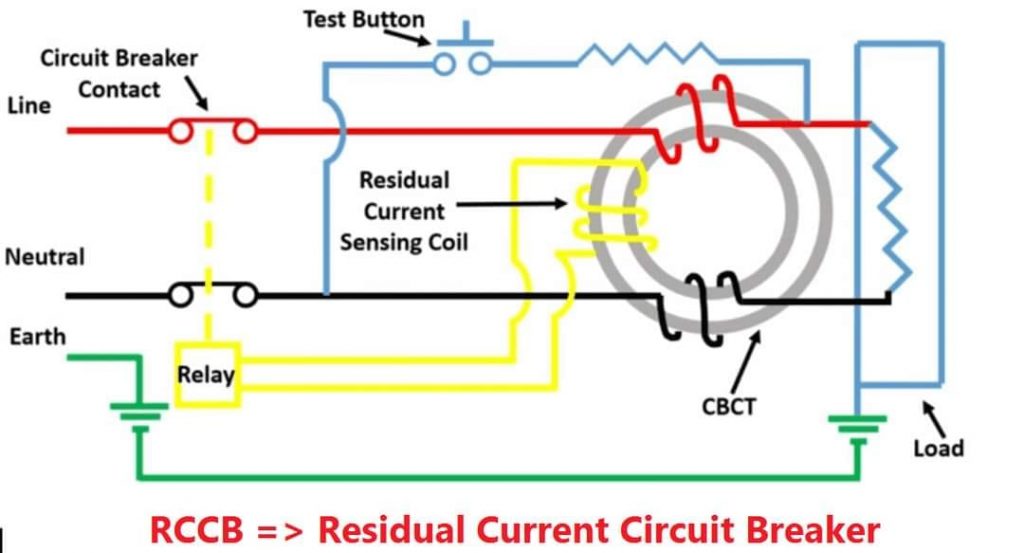Residual Current Circuit Breaker (RCCB)
What is Residual Current Circuit Breaker (RCCB)
A Residual Current Circuit Breaker (RCCB) is an important safety measure when it comes to protection of electrical circuits. It is a current sensing device, which can automatically measure and disconnect the circuit whenever a fault occurs in the connected circuit or the current exceeds the rated sensitivity.
Principle behind RCCB

RCCB works on the principle of Kirchhoff’s law, which states that the incoming current must be equal to the outgoing current in a circuit. RCCB thus compares the difference in current values between live and neutral wires. Ideally, the current flowing to the circuit from the live wire should be the same as that flowing through the neutral wire. In case of a fault, the current from the neutral wire is reduced, the differential between the two known as Residual Current. On spotting a Residual Current, the RCCB is triggered to trip off the circuit.
A test circuit included with the Residual Current device ensures that the reliability of RCCB is tested. When the test button is pushed, the current starts to flow through the test circuit. As it creates an imbalance on the neutral coil of the device, the RCCB trips and supply is disconnected thereby checking RCCB’s reliability.
Benefits of RCCB
- Provides protection against earth fault as well as any leakage current
- Automatically disconnects the circuit when the rated sensitivity is exceeded
- Offers possibility of dual termination both for cable and busbar connections
- Offers protection against voltage fluctuation as it includes a filtering device that guards against transient voltage levels.
Sensitivity of RCCB
A human being is able to sustain an electric shock to the extent of 30 mA. While upto 10 mA may just evoke a prickling sensation, 10 mA onwards may lead to muscular contraction, further leading to a respiratory paralysis at around 30mA. RCCBs are therefore designed to look for small changes in residual current. In cases where protection from fire is sought, RCCBs are also used to track higher changes in residual current of up to 300mA.
Limitations of RCCB
While RCCB has many advantages, it has some limitations as well:
- RCCB does not guarantee to operate if none standard waveforms are generated by loads. It’s mainly because RCCB is designed to operate on normal supply waveforms.
- There might be some unwanted tripping of RCCB. It’s mainly because whenever there are sudden changes in electrical load, there can be small current flow to earth especially in old appliance.
- RCCB does not protect from current overload. It has been designed to protect only when the live current and neutral current are different. However, a current overload cannot be detected.
- RCCB does not protect against line-neutral shocks. It’s mainly because current in them is balanced. The current gets balanced as both terminals are held together.
- RCCB does not protect from the overheating that strike if conductors are not properly screwed into terminals.
Classification of RCCB
RCCB are of two types; the 2 Pole RCCB and 4 Pole RCCB.
2 Pole RCCB:
This is used in case of a single-phase supply connection that has only a live and a neutral wire.
4 Pole RCCB:
This is used in case of a three-phase supply connection.
Rating from 10 Amp ….100 Amp
Sensitivity 30,100,300 m Amp
RCCB is therefore extremely important in providing real time protection for circuits. In industries and high voltage commercial set ups especially, its importance cannot be undermined as there is always risk of shocks and accidental deaths on account of it. At C&S Electric, we offer Wintrip RCCB, a state-of-the-art product fit for industrial, residential and commercial application. C&S RCCBs conforms to IEC 61008 – 1 and is used for both control and isolation of electrical circuits. Being a respected global brand for power management products for over 50 years, with C&S Electric you can rest assured knowing that you are in safe hands.